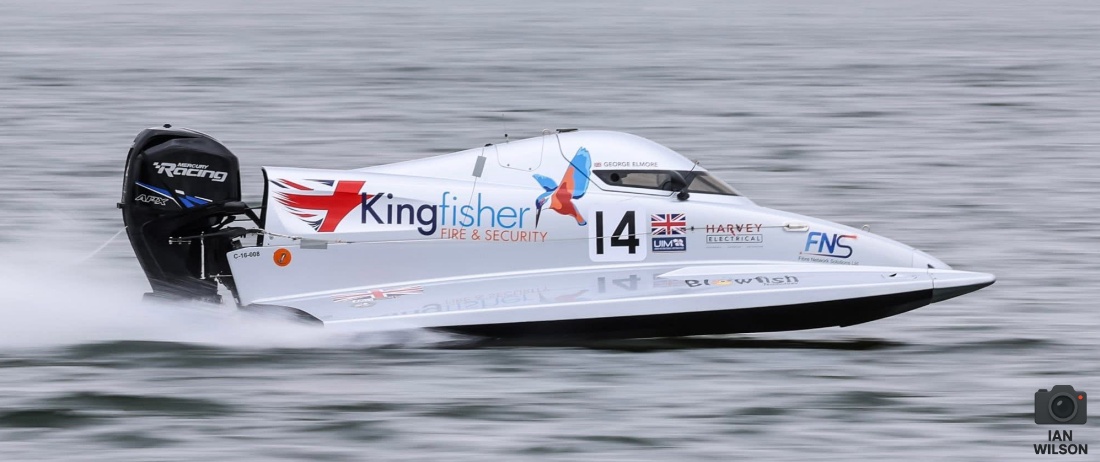F4 crash boxes will become mandatory for all boats built after 1st January 2026 under proposals facing a UIM Council vote tomorrow, with detailed homologation specifications demanding multi-layer foam construction capable of absorbing 1.2 kilojoules during drop tests to reduce driver injuries in lateral collisions.
France and COMINSAFE have submitted complementary proposals establishing F4 crash boxes requirements, increasing F4 minimum weight to 370 kilograms and introducing rear-mounted balloon airbags with delayed activation, addressing cockpit destruction patterns observed in side-impact accidents.
Crash Box Specifications
COMINSAFE’s homologation requirements mandate F4 crash boxes measuring 60 to 80 millimetres thickness constructed from layered sequences of foam and skin materials with no hollow areas permitted. The volume must feature at least three foam layers with intermediate skins in the main area, with additional layers permitted based on manufacturer design choices.
The covered area extends full thickness between the bulkhead and dashboard excluding top radius sections, with volumes allowed within prescribed minimum dimensions. Typical construction employs materials including Kevlar/Carbon 180, Carbon TC 200 P, Aramid KK-172 P, Carbon UD 200 and Flexcell F80 foam in 20-millimetre layers, though material selection remains free provided test results satisfy homologation criteria.
Bob Wartinger’s justification emphasises reducing driver injury possibilities in collisions. The Safety Cockpit Committee, Formulae Committee, COMINSPORT, COMINTECH and COMINSAFE have reviewed the technical specifications, with ISATEC homologation information providing reference material for constructor guidance.
Drop Test Requirements
Manufacturers must construct 300-millimetre square test panels demonstrating minimum absorbed energy of 1.2 kilojoules during drop tests with maximum penetration limited to box thickness plus 73 millimetres. Tests must occur at minimum velocity of 5 kilometres per hour using steel impactors, ensuring dynamic character validates real-world collision performance.
Documentation submitted for homologation must contain design specifications including geometry, setup and material listings alongside drop test results showing absorbed energy, g-time graphs and force-displacement graphs. Video documentation remains optional but recommended for validation purposes.
Each production lot requires full documentation demonstrating compliance with specifications. New production lots using identical materials and production methods need only manufacturing documentation rather than complete revalidation. Any modifications including additional components for run-out zones demand updated documentation following identical procedures.
Installation Requirements
Permanent gluing across the entire interface between crash box and cockpit ensures shear strength during accidents. Border areas must demonstrate minimum shear strength of 1 newton per square millimetre, whilst inner areas require 0.5 newtons per square millimetre minimum. Shear test documentation with photographs and results must accompany homologation submissions.
F4 crash boxes require individual numbering for traceability, with manufacturers maintaining identification lists covered by homologation documentation. The requirement applies exclusively to F4 boats built after 1st January 2026, exempting existing vessels from retrofit obligations whilst establishing standards for all future construction.
Ramasco Yacht Design developed the crash box solution based on Formula 1 technologies originally designed by ISATEC. However, RYD’s disclaimer emphasises manufacturers must separately address required modifications or reinforcements to boat structures, cockpits and specific components. Aerodynamic behaviour influences and technical interactions between F4 crash boxes and vessels remain individual manufacturer responsibilities.
Weight Compensation
COMINSAFE proposes increasing F4 minimum weight from 360 kilograms to 370 kilograms, compensating for crash box construction mass. Tested sample constructions demonstrate typical crash box assemblies weighing approximately 10 kilograms including multi-layer foam, intermediate skins and permanent adhesive bonding materials.
The weight increase maintains competitive balance whilst ensuring constructors can meet structural requirements without excessive material reduction elsewhere. Minimum dimensions remain unchanged at 3.90 metres length with mandatory reinforced cockpits, preserving class characteristics whilst enhancing lateral impact protection.
Balloon Airbag Requirement
France’s complementary proposal mandates balloon airbags at rear cockpit positions with five-second delayed activation for F4 boats built from 1st January 2026. Gilles Guignard’s justification addresses flip and rolling accidents where boats remain inverted in flat positions, trapping drivers underwater.
The rear-mounted balloon airbag with delayed dispositive ensures vessels rotate to upright positions, placing drivers above water level during rescue operations. The system complements existing delayed-operation buoyancy airbag requirements for composite-sandwich sponson construction in S2000, S3000, S Infinity, SL 250 and Endurance S1/S2 classes.
Current regulations require airbag replacement after five years from production or installation dates. The proposed F4 balloon airbag would follow identical lifespan requirements, maintaining consistency across safety equipment replacement schedules. COMINSPORT, COMINTECH, COMINSAFE, the Safety Cockpit Committee and Formulae Committee have reviewed the proposal.
Safety Philosophy
The F4 crash boxes requirement reflects observations of cockpit destruction patterns in lateral accidents. France’s initial proposal to Rule 542.03 states F4 cockpits are destroyed in side-impact scenarios, creating driver injury risks that current reinforced cockpit specifications cannot fully address. The multi-layer foam construction with intermediate skins distributes impact forces across broader areas whilst absorbing collision energy through controlled deformation.
The approach mirrors automotive motorsport safety evolution, where side-impact protection structures became mandatory after accident analysis revealed vulnerability patterns. Formula 1’s crash box developments demonstrated energy absorption effectiveness, providing validated engineering principles for powerboat applications despite different operating environments.
However, RYD’s disclaimer acknowledges F4 crash boxes cannot guarantee injury or fatality prevention in side impacts or other accident types even when correctly installed. The technology reduces risk probability and injury severity rather than eliminating dangers inherent to high-speed powerboat racing. Manufacturers bear responsibility for comprehensive safety analysis beyond crash box installation alone.
Implementation Timeline
The 1st January 2026 implementation date provides constructors sufficient time to develop homologation documentation, conduct required testing and modify production processes. Boats already under construction or completed before the deadline remain exempt, preventing retrospective compliance costs for existing competitors whilst establishing clear standards for future builds.
Manufacturers must submit electronic documentation to UIM containing complete design specifications, test results, shear test data with photographs and numbered box identification lists. The homologation process creates traceability throughout crash box lifecycles from manufacture through installation to potential accident investigation.
The council vote on all four proposals takes place during the 98th UIM General Assembly on Friday 10th October 2025. If approved, the crash box requirement, weight increase and balloon airbag mandate would all take effect from 1st January 2026, creating comprehensive lateral impact protection upgrades for Formula 4.

John Moore’s involvement in powerboat racing began in 1981 when he competed in his first offshore powerboat race. After a career as a Financial Futures broker in the City of London, specialising in UK interest rate markets, he became actively involved in event organisation and powerboat racing journalism.
He served as Event Director for the Cowes–Torquay–Cowes races between 2010 and 2013. In 2016, he launched Powerboat Racing World, a digital platform providing global powerboat racing news and insights. The following year, he co-founded UKOPRA, helping to rejuvenate offshore racing in the United Kingdom. He sold Powerboat Racing World in late 2021 and remained actively involved with UKOPRA until 2025.
In 2025, he established Powerboat News, returning to independent journalism with a focus on neutral and comprehensive coverage of the sport.



